Faced with acrylic’s glass-like transparency, many people question the true nature of this material: “Is acrylic plastic?”
This question has sparked numerous discussions and misunderstandings.
In reality, acrylic is an important and early-developed thermoplastic polymer known for its excellent transparency, chemical stability, and weather resistance, making it widely used in the construction industry.
This article will explore the composition, properties, and applications of acrylic to uncover the truth about this fascinating material.
What Is Acrylic?
Acrylic, also known as PMMA or plexiglass, is a polymer formed by the polymerization of methyl methacrylate (MMA) and is classified as a thermoplastic material.
The research and development of acrylic spans over a century. As early as 1872, the polymerization properties of acrylic acid were discovered.
By 1901, the synthesis methods for acrylic esters were established, and in 1927, efforts began to apply these methods to industrial production.
In 1937, the successful industrial production of methacrylate esters enabled large-scale manufacturing.
With continuous technological advancements, acrylic materials have been widely used across various industries, particularly in construction and advertising.
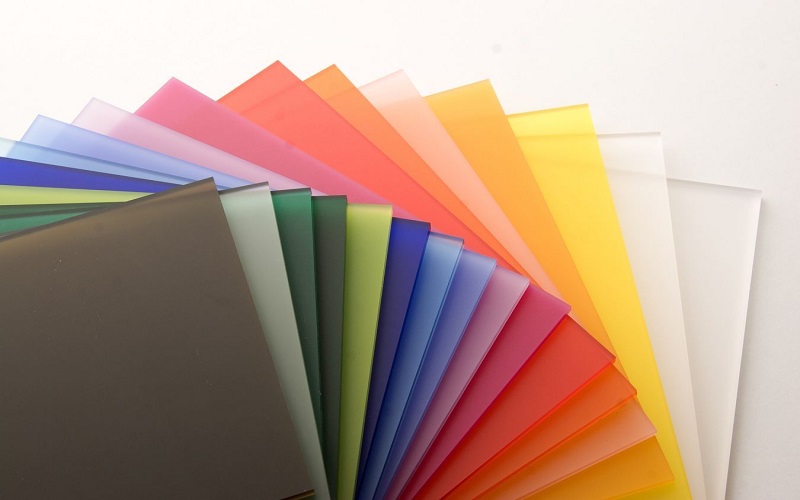
The Properties Of Acrylic Material
Using acrylic sheets as an example, acrylic material exhibits the following key characteristics:
- Transparency
Acrylic has crystal-like transparency, with a light transmittance rate exceeding 92%, earning it the nickname “Queen of Plastics.”
- Weather Resistance
Acrylic offers excellent resistance to weathering and atmospheric aging, maintaining its properties even after prolonged outdoor exposure, making it ideal for outdoor use.
- Workability
Acrylic sheets are highly workable, allowing for both thermal forming and mechanical processing, which provides great versatility in design and fabrication.
- Printability and Paintability
With the right printing and coating techniques, acrylic products can achieve desired surface decoration effects, enhancing both aesthetics and functionality.
- Flammability
Acrylic is not self-igniting but is classified as a flammable material and does not have self-extinguishing properties, requiring appropriate safety precautions during use.
|
Property |
ASTM |
Unit |
Value |
|
OPTICAL |
|
||
|
Light Transmission |
D1003-61 |
% |
92 |
|
Refractive Index |
D542 |
|
1.49 |
|
MECHANICAL |
|
||
|
Tensile Strength |
D638 |
PSI |
|
|
Rupture |
|
PSI |
11.000 |
|
Modulus of Elasticity |
|
PSI |
400.000 |
|
Impact Strength |
D256 |
|
|
|
Izod Notched |
|
FT.LBS |
0.4 |
|
Rockwell hardness |
D785 |
|
M-95 |
|
Barcol Hardness |
D2583 |
|
50 |
|
THERMAL |
|
||
|
Thermoforming Temperature |
℃ |
|
140-180 |
|
Heat Distortion Temperature |
|
|
|
|
2 ℃ /MIN.-264PSI |
D648 |
℃ |
101 |
|
Coefficient of Thermal Conductive |
|
BTU/HR(FT2)(0F/IN) |
1.4 |
Is Acrylic A Glass Or Plastic?
Glass is an inorganic, non-metallic material primarily composed of silica and other oxides, formed through high-temperature melting and subsequent cooling.
Although glass features high transparency and a smooth surface, it is harder and more brittle than acrylic, making it prone to breaking and shattering.
In contrast, acrylic is an organic polymer material made from the polymerization of methyl methacrylate and other organic compounds, categorizing it as a type of plastic.
Acrylic boasts excellent transparency, chemical stability, and weather resistance, and it is easy to dye and process.
Its attractive appearance and versatility allow it to be shaped into various forms through injection molding, extrusion, and thermoforming.
Despite being commonly referred to as “organic glass,” this nickname does not change the fact that acrylic is fundamentally a plastic.
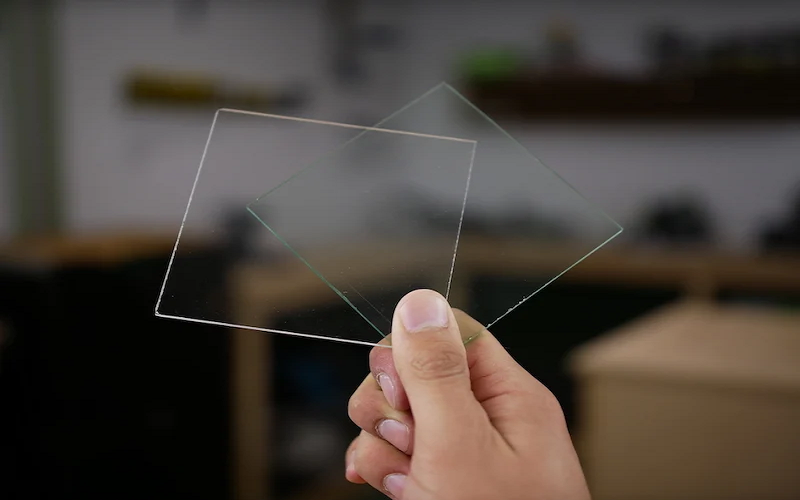
The Process Of Acrylic(PMMA) Injection Molding
In the text above, we learned that acrylic injection molding is a common processing method for acrylic plastic, involving the following steps and considerations:
Material Handling: PMMA has a certain level of water absorption, with an absorption rate of 0.3-0.4%.
For injection molding, the moisture content must be below 0.1%, typically around 0.04%.
Therefore, drying treatment is required, with a drying temperature of 80-90°C for at least 3 hours.
Mold and Gate Design: The mold temperature should be set between 60-80°C. The main runner diameter should match the internal taper, with an optimal angle of 5° to 7°.
For products with a wall thickness greater than 4mm, the angle should be 7°, and the main runner diameter should be 8-10mm.
The overall gate length should not exceed 50mm. For products with a wall thickness less than 4mm, the runner diameter should be 6-8mm, while for products with a wall thickness greater than 4mm, the runner diameter should be 8-12mm.
Common vent depths should be within 0.05mm, with a width of 6mm, and the draft angle should range from 30′ to 1°.
Melt Temperature: The melt temperature can be measured using the air shot method, ranging from 210-270°C.
The exact temperature should be determined based on the information provided by the supplier.
Injection Speed: Fast injection can be used, but to avoid high internal stress, multi-stage injection is recommended, such as a slow-fast-slow pattern.
For thick walled parts, slow injection should be used to ensure proper molding quality.
Acrylic injection molded products are renowned for their high transparency and smooth surfaces, achieving an effect comparable to glass.
Additionally, acrylic offers excellent corrosion resistance and high-temperature stability, making it resistant to aging and yellowing.
This makes acrylic plastic not only play a crucial role in industrial production but also widely used in everyday life, becoming an indispensable part of modern living.
What Is Acrylic Plastic Used For?
Acrylic plastic (PMMA), also known as plexiglass, features high transparency, chemical stability, and weather resistance.
It is easy to dye and process, making it widely applicable across various fields.
Here are some of the main uses of acrylic plastic:
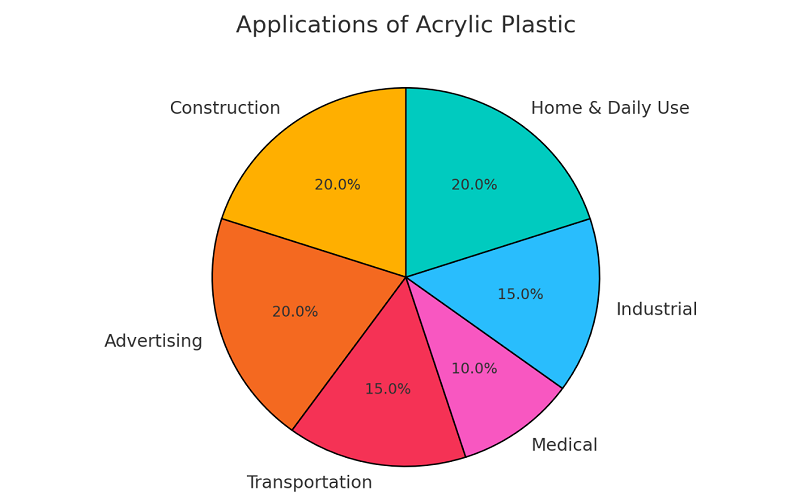
-
Construction
Acrylic can be used as a substitute for glass in construction materials due to its superior impact resistance and excellent aging resistance.
It is ideal for applications such as display windows, soundproof doors and windows, skylights, and phone booths.

-
Advertising
With its smooth surface and vibrant colors, acrylic is perfect for advertising facilities such as light boxes, signs, billboards, and display stands.
Transparent acrylic sheets can serve as back panels, while translucent and opaque sheets are suitable for creating signs, letters, and graphics.
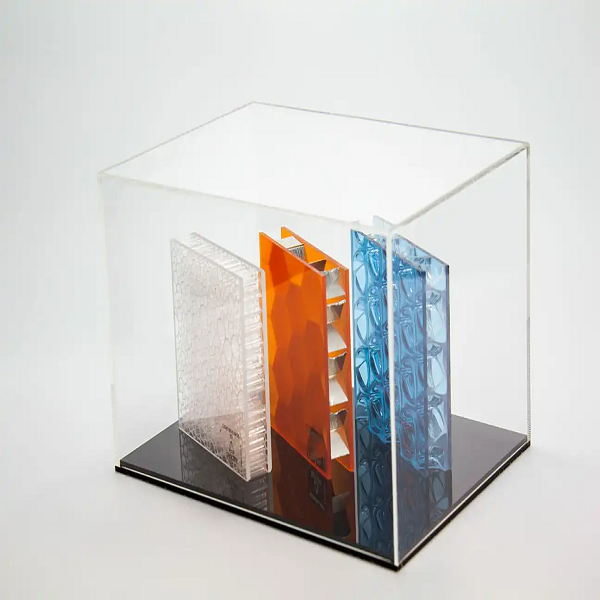
-
Transportation
The transportation industry often sources high-abrasion and impact-resistant acrylic sheets from acrylic sheet manufacturers for use in light covers and other exterior components of trains and automobiles, ensuring product durability and safety.
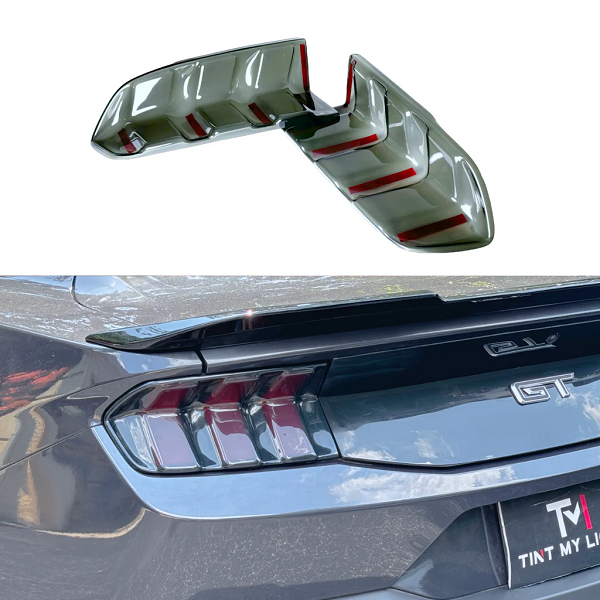
-
Medical
Due to its resistance to decomposition, ease of cleaning, and excellent corrosion resistance, acrylic is used in medical devices such as infant incubators and surgical instruments.
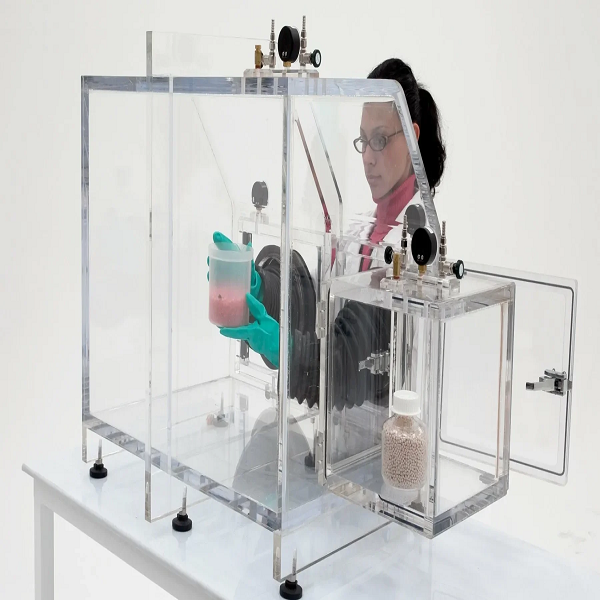
-
Industrial
Acrylic is used for instrument panels and protective covers in industrial equipment.
Its lightweight, cost-effectiveness, ease of forming, and simple manufacturing process make it a practical choice.
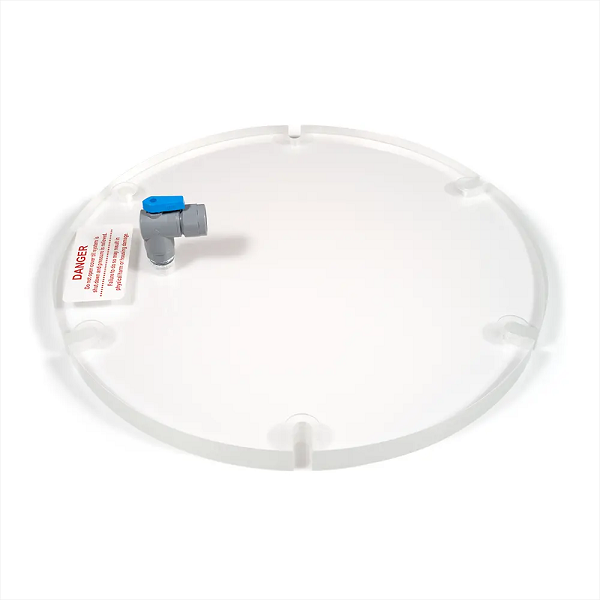
-
Home & Daily Use
Acrylic products are widely used in home and daily life applications, such as display cases, bathroom fixtures, decorative items, cosmetic containers, stands, and aquariums.
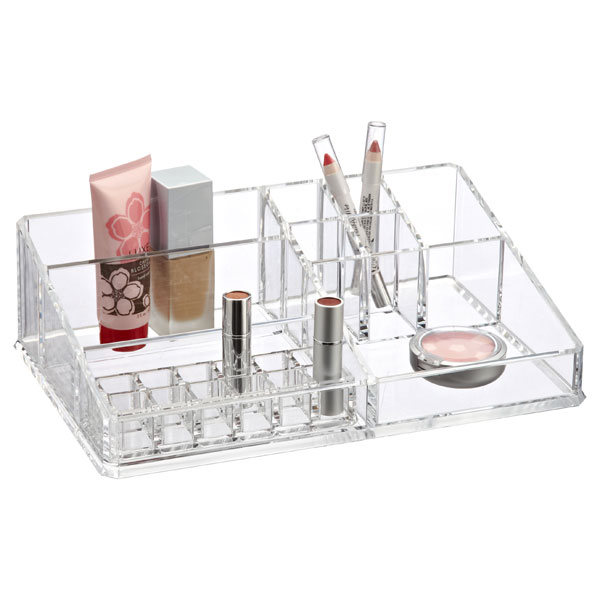
Is Acrylic Plastic Safe ?
The main component of acrylic plastic is polymethyl methacrylate (PMMA), which is non-toxic and does not release harmful substances under normal temperature and usage conditions.
This makes it widely used in food display cases, beverage dispensers, and other products that come into contact with food.
However, acrylic is not heat-resistant. In high-temperature environments or under strong ultraviolet radiation, it may degrade and release small amounts of volatile organic compounds (VOCs), which could pose health risks in enclosed or poorly ventilated spaces.
Additionally, during the processing of acrylic, particles or volatile substances may be produced, and prolonged exposure to these may cause skin irritation or respiratory discomfort.
Therefore, while acrylic is safe for normal use and contact with food, it is crucial to avoid exposing it to high temperatures or prolonged strong light to ensure comprehensive safety.
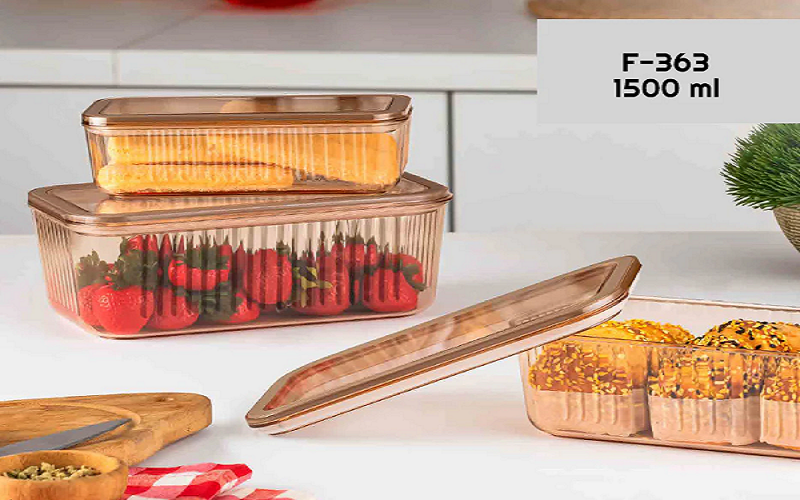
Is Acrylic Recyclable Plastic?
Theoretically, acrylic is a thermoplastic material with good recyclability, making it a recyclable plastic.
However, several technical and economic challenges need to be addressed.
Firstly, the quality and efficiency of acrylic recycling are highly dependent on the technology used to separate contaminants.
Mechanical and physical recycling methods may not be able to remove additives and impurities from the material, which limits the scope of its reuse.
Although chemical recycling methods can address these issues, they are technologically complex and costly, and thus not yet widely implemented.
Secondly, the recycling and reuse of acrylic sheets require a well-established recycling infrastructure and market, which may not be fully developed in some regions.
Therefore, while acrylic plastic has strong recycling potential, challenges remain in the recycling process, necessitating further efforts at both the technological and policy levels.
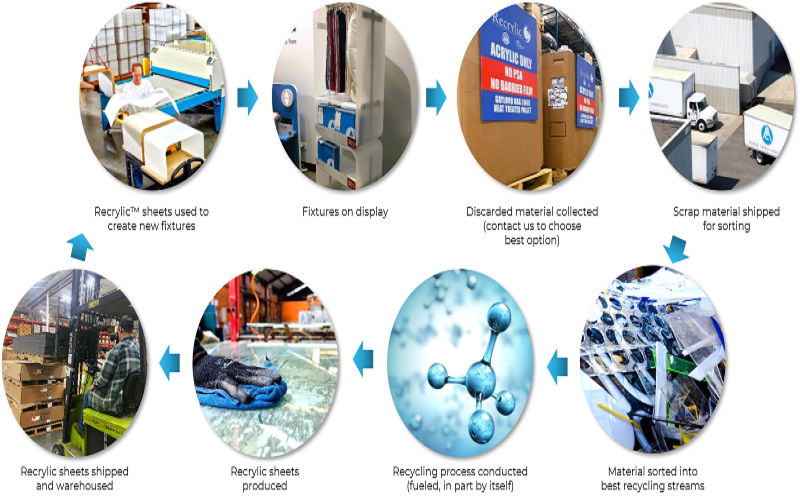
How To Distinguish Plexiglass And Acrylic?
The word “acrylic” is derived from the English term “acrylic” and refers to PMMA sheets produced from the organic compound MMA, which offer glass-like transparency and excellent light transmission.
Since all transparent plastic sheets, including those made from materials like PS, PC, or low-grade recycled MMA, are generally called plexiglass, high-quality PMMA sheets made from pure MMA are specifically labeled as acrylic sheets to set them apart from ordinary plexiglass.
If you want to learn more about the differences between Plexiglass and Acrylic, you can refer to resources on “Plexiglass vs Acrylic“
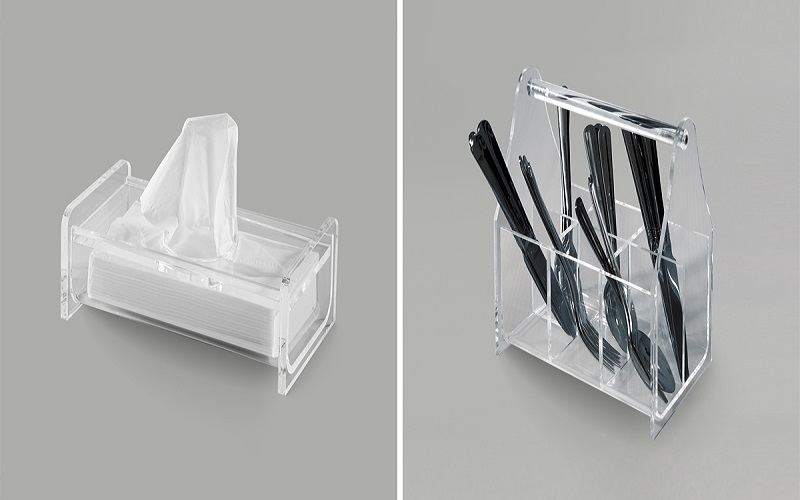
Conclusion
In summary, acrylic is a polymer material made from polymethyl methacrylate (PMMA) and is indeed classified as plastic.
Its exceptional transparency, weather resistance, and ease of processing make it widely used in construction, advertising, transportation, and home applications.
Although acrylic is often referred to as “plexiglass,” this is simply a descriptive nickname and does not change the fact that it is a type of plastic.
Therefore, to answer the question “Is Acrylic Plastic” the clear response is that acrylic is certainly a high-performing plastic.
